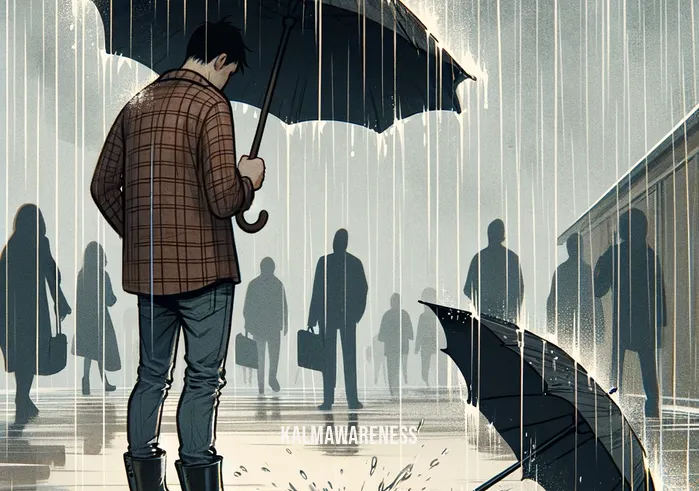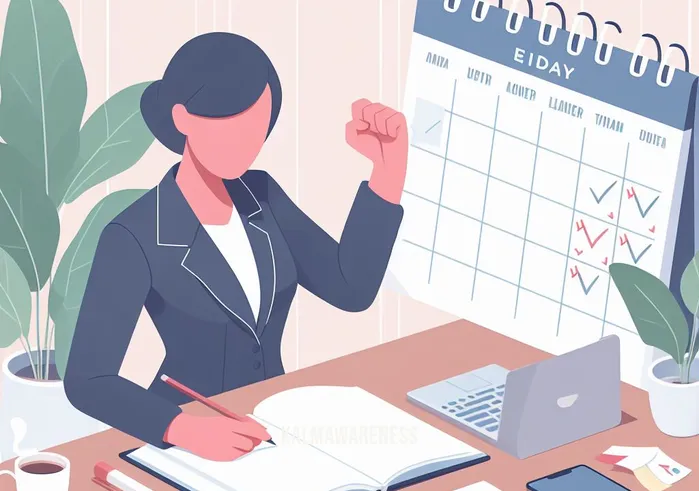The Transformative Power of Bad Day Pictures in Enhancing Health and Well-being
We’ve all had those days where nothing seems to go right. From minor inconveniences to major setbacks, bad days are an inevitable part of life. However, there’s a unique aspect to these challenging times that often goes unnoticed: the power of ‘bad day pictures’. These are the snapshots of our struggles and frustrations, capturing moments that, while difficult, can play a significant role in our journey towards health and well-being.
Embracing the Unpleasant: A Pathway to Mindfulness
Mindfulness is a state of active, open attention to the present. When we take pictures of our bad days, we’re doing more than just documenting our struggles. We’re practicing a form of mindfulness, acknowledging our current emotions and experiences without judgment. This act can be surprisingly therapeutic. By capturing these moments, we’re not dwelling on the negative but rather observing it from a different perspective, one that allows us to process our emotions more healthily.
The Role of Mindful Movement and Sleep
A bad day often leaves us feeling drained and stressed. This is where mindful practices like mindful movement and sleep can be particularly beneficial. Mindful movement, such as yoga or gentle stretching, helps to release the tension built up in our bodies. Coupled with good sleep hygiene, it ensures that we recover both physically and mentally from the day’s challenges.
EMDR Meditation: A Tool for Processing
Another powerful tool in our wellness toolkit is EMDR (Eye Movement Desensitization and Reprocessing) meditation. This form of meditation helps in processing the emotions and memories associated with bad days. By focusing on bilateral stimulation, such as eye movements, we can help the brain reprocess these experiences, reducing their emotional impact.
Finding Relaxation Amidst Chaos
On a bad day, relaxation might seem like a distant dream. Yet, it’s crucial for our well-being. Techniques such as floating meditation and relaxation exercises offer a respite from the chaos. Floating meditation, in particular, provides a unique sensory deprivation experience that can help calm an overstimulated mind.
Mindfulness for ADHD
Adults with ADHD often find bad days especially overwhelming. The constant influx of stimuli can be exhausting. However, mindfulness practices tailored for ADHD can offer significant relief. These practices help in managing impulsivity and hyperactivity, making it easier to navigate challenging days.
The Healing Power of Breath and Movement
The simple act of breathing can be incredibly powerful. Practices like mindful breathing help center our thoughts and emotions, providing a sense of calm and clarity. Similarly, hand yoga poses can be a quick and effective way to release stress and restore balance.
Using Sound Frequencies for Healing
Sound therapy, such as binaural beats and 256 Hz sound frequencies, can also play a role in turning a bad day around. These sound frequencies are known to induce states of relaxation and can even alleviate specific issues like migraines.
Integrating Meditation into Everyday Life
Incorporating meditation into our daily routine can significantly impact how we handle bad days. Whether it’s a more traditional approach like meditation for dummies or specific techniques for beginners by experts like Jack Kornfield, these practices equip us with the tools to maintain our composure even on the toughest days.
Creating a Sanctuary in Your Space
Finally, our physical environment plays a crucial role in how we experience and recover from bad days. Creating a calming space, perhaps a bed in the clouds, can be a sanctuary where we can retreat, reflect, and rejuvenate.
As we continue to explore the multifaceted approach to dealing with bad days and enhancing our well-being, remember that each challenge carries with it an opportunity for growth and healing. In the next chapter, we will delve deeper into specific strategies and practices that can transform our experience of difficult days, guiding us towards a more resilient and balanced life. Stay tuned to uncover more insights and tools that can help you navigate life’s ups and downs with grace and strength.

Harnessing the Power of Reflection Through Bad Day Imagery
Bad day pictures, or snapshots capturing our challenging moments, serve as powerful tools for reflection and personal growth. In this chapter, we delve deeper into how these images can be used effectively to enhance our mental and emotional well-being. By exploring various approaches and techniques, we can turn our worst moments into catalysts for positive change.
The Healing Journey: Capturing and Reflecting
The Role of Bad Day Pictures in Self-Reflection
- Documentation of Emotional States: Capturing moments of distress or frustration helps in acknowledging and understanding our emotional responses.
- Visual Timeline of Progress: Over time, these pictures can illustrate our journey through difficult periods, showing how far we’ve come.
- Trigger for Constructive Conversation: Sharing these images with therapists or trusted individuals can open doors for meaningful discussions about mental health.
Strategies for Using Bad Day Imagery
- Journaling Alongside Images: Pair your photos with written reflections to deepen your understanding of your emotional landscape.
- Mindful Review: Regularly revisiting these images mindfully can help you notice patterns and triggers in your life, aiding in proactive mental health management.
- Artistic Transformation: Turn these images into art, symbolically transforming negative experiences into creative expressions.
Structuring Reflection: Lists and Tables
Techniques for Effective Use of Bad Day Pictures
- Create a routine for capturing and reflecting on difficult moments.
- Use mindful breathing or meditation to ground yourself before and after viewing these pictures.
- Consider yoga poses or physical activities to release any tension triggered by these images.
- Engage in floating meditation to help process the emotions these pictures bring up.
Table: The Impact of Bad Day Pictures on Mental Health
| Aspect of Well-being | Impact of Bad Day Pictures | Strategies for Positive Use |
|---|---|---|
| Emotional Awareness | Increases awareness of emotional patterns | Journaling and Discussion |
| Stress Management | Identifies stress triggers | Mindfulness and Meditation |
| Self-Esteem | Boosts confidence by showing progress | Artistic Expression |
| Resilience | Enhances ability to bounce back | Reflective Reviewing |
| Communication | Improves ability to express feelings | Sharing in Therapy or Support Groups |
Beyond the Image: Other Tools for Well-being
While bad day pictures are a significant aspect of self-reflection and emotional processing, they are just one part of a larger toolkit for mental well-being. Incorporating other practices such as meditation and mindful movement can amplify the benefits gained from these reflective exercises.
Integrating Complementary Practices
- Combine bad day picture reflections with mindful movements for a holistic approach to stress release.
- Engage in practices like floating meditation after a reflection session to help process and release emotions.
- Use binaural beats or 256 Hz frequencies to create a calming ambiance during reflection times.
Preparing for the Next Chapter: Expanding Our Toolkit
As we move forward, it’s important to remember that the journey of self-improvement and emotional well-being is ongoing and multifaceted. In the next chapter, we will explore additional methods and strategies that complement the use of bad day pictures, providing you with a more comprehensive toolkit for managing life’s challenges. Stay tuned to learn how to further harness your experiences for personal growth and resilience.

Illuminating Hope Through the Lens of Struggle: The Story of Bad Day Pictures
In the journey of life, bad days are as much a part of the narrative as the good ones. Bad day pictures, or visual mementos of our struggles, hold within them the seeds of inspiration and hope. This chapter explores how these snapshots of our less-than-perfect moments can be a source of profound inspiration and a catalyst for positive transformation.
The Inspirational Power of Visual Struggles
Capturing Moments of Resilience
Bad day pictures are not just about capturing moments of distress; they are a testament to our resilience. Each image tells a story of survival and strength, reminding us that we are capable of overcoming challenges. They are visual affirmations that “This too shall pass.”
Quotes That Resonate with Hope
- “In the midst of winter, I found there was, within me, an invincible summer.” – Albert Camus
- “The human capacity for burden is like bamboo – far more flexible than you’d ever believe at first glance.” – Jodi Picoult
- “Turn your wounds into wisdom.” – Oprah Winfrey
- “New beginnings are often disguised as painful endings.” – Lao Tzu
- “The darkest hour has only sixty minutes.” – Morris Mandel
These quotes resonate with the essence of bad day pictures, emphasizing that within every challenge lies an opportunity for growth and enlightenment.
Real-Life Inspirations: Stories Behind the Pictures
Case Study: Overcoming Adversity
Consider the story of Emily, a young entrepreneur. Her series of ‘bad day’ pictures during a challenging business phase became a powerful narrative of her journey. From moments of doubt to financial hurdles, each picture marked a step in her path to eventual success. Emily’s story illustrates how capturing our low points can retrospectively become a roadmap of our resilience.
Transforming Challenges into Opportunities
- Learning from Failure: Each picture of a ‘bad day’ can teach us something about ourselves, our limits, and our potential for growth.
- Inspiring Others: Sharing these images and stories can be a source of motivation for others facing similar challenges.
- Fostering Empathy: Seeing and sharing struggles fosters a sense of shared human experience, building empathy and understanding.
The Role of Community in Finding Inspiration
Building a community around the concept of sharing and reflecting on bad day pictures can amplify their inspirational power. Platforms like Kalm Awareness offer spaces for individuals to share their experiences, providing support and inspiration to others.
Embracing the Philosophy of ‘Kid Calm’
Integrating practices that foster a ‘kid calm’ mindset, as promoted by Kalm Awareness, can be particularly beneficial. This approach encourages viewing challenges with a sense of curiosity and openness, akin to a child’s perspective, which can be a refreshing way to approach bad days.
The Intersection of Art and Healing
Artistic expression offers another avenue to transform the experience captured in bad day pictures into something transformative and inspiring. This can include creating visual art, writing, or even composing music inspired by these moments.
Leveraging Art for Emotional Release
- Photography and Painting: Use your bad day pictures as a basis for creating artwork, channeling emotions into creativity.
- Writing and Storytelling: Write stories or poems inspired by these images, weaving narratives of hope and resilience.
- Music and Sound: Compose music or soundscapes that reflect the emotions captured in these pictures, using rhythm and melody to process and release feelings.
Gearing Up for the Next Step: Embracing Change
As we move forward in our journey, it’s important to remember that change is the only constant. In the next chapter, we will explore how to embrace change, using bad day pictures as a tool for adapting and thriving in the face of new challenges. We’ll uncover strategies to turn these snapshots of struggle into stepping stones for personal evolution and growth. Join us as we continue to discover the transformative power of our own stories.
@
Unraveling the Complexities: A Closer Look at Bad Day Images
As we journey further into understanding bad day pictures, it becomes essential to break down their various aspects. This chapter aims to dissect these images, exploring their multifaceted nature and how they can be a vital tool in our emotional and mental toolkit. Through lists and bullet points, we’ll delve deeper, providing fresh insights and practical ways to utilize these snapshots of our challenges.
The Anatomy of a Bad Day Picture
Bad day pictures, or snapshots of challenging moments, are more than just images. They’re a complex blend of emotions, lessons, and potential growth.
Components of a Bad Day Image
- Visual Element: The actual image, capturing a moment of struggle or distress.
- Emotional Context: The feelings and emotions that the image represents.
- Narrative Potential: The story behind the image and what it conveys about the individual’s experience.
Practical Uses of Bad Day Pictures
Personal Growth and Reflection
- Self-Analysis: Reviewing these pictures to understand personal triggers and stressors.
- Therapeutic Aid: Using the images as a discussion point in therapy or support groups.
- Resilience Building: Recognizing personal growth and resilience through these visual reminders.
Community and Shared Experiences
- Discussion Starters: Sharing these pictures in supportive communities for collective reflection and advice.
- Empathy Building: Using these images to foster understanding and empathy within a community or group setting.
The Emotional Spectrum of Bad Day Pictures
Bad day pictures can evoke a wide range of emotions, each carrying its significance and opportunity for growth.
Emotional Responses and Management Strategies
- Sadness: Acknowledging this feeling and using tools like journaling to process it.
- Frustration: Channeling this emotion into productive activities or mindful exercises.
- Anxiety: Practicing relaxation techniques such as deep breathing or mindfulness meditation.
Transforming Images into Tools for Healing
Steps to Utilize Bad Day Pictures Effectively
- Capture: Take a moment to photograph your challenging moment.
- Reflect: Spend time reflecting on the image, acknowledging your feelings.
- Analyze: Identify any patterns or triggers evident in the picture.
- Discuss: Share the image with a therapist, friend, or support group for further insight.
- Transform: Use the insights gained to make positive changes or adopt new coping strategies.
Preparing for the Final Chapter: Culmination and Continuation
As we conclude this chapter, we stand on the brink of tying together all that we’ve learned about bad day pictures. In the next and final chapter, we will bring together the insights, strategies, and experiences shared so far, culminating in a comprehensive understanding of how these images can be transformative tools. We will also look ahead, exploring how to continue applying these lessons in our journey towards emotional resilience and well-being. Join us as we prepare to wrap up this enlightening exploration, ready to embark on a path of continued growth and self-discovery.
@
Reflecting on the Journey: The Transformative Role of Bad Day Pictures
As we reach the conclusion of our exploration into the world of bad day pictures, it’s time to reflect on the lessons learned and the insights gained. These snapshots of our challenging times, far from being mere reminders of struggle, have emerged as valuable tools for personal growth, emotional healing, and communal support.
Summarizing Our Journey
Key Insights on Bad Day Imagery
- Capturing Resilience: We’ve seen how these images document not just our struggles but also our resilience and capacity to overcome.
- Emotional Awareness: Bad day pictures have opened a window into understanding our emotions, enabling us to confront and manage them effectively.
- Community and Empathy: Sharing these experiences has highlighted the power of community in providing support and fostering empathy.
The Lighter Side of Bad Days
While the concept of a ‘bad day’ often carries a negative connotation, our journey has shown us the silver lining. These moments, captured in images, serve as important milestones in our personal narratives, teaching us valuable lessons and reminding us of our strength and adaptability.
Applying the Lessons in Real Life
Moving Forward with a New Perspective
- Embrace each bad day picture as a learning opportunity.
- Reflect on these images to gain a deeper understanding of your emotional patterns.
- Share your journey with others, either in personal conversations or through community platforms, to inspire and uplift.
A Call to Action: Continue the Exploration
This series on bad day pictures is just the beginning. We invite you to delve deeper into the world of mindfulness and personal growth through our other resources. Revisit previous chapters for a refresher, or explore new content in our magazine that aligns with your journey towards emotional well-being.
Explore More
- For more on mindfulness and emotional well-being, check out our sections on mindful movement, meditation techniques, and stress management strategies.
Expressing Gratitude
We thank you, our readers, for joining us on this enlightening journey. Your engagement and willingness to explore the depths of personal experiences have made this exploration into bad day pictures a meaningful endeavor.
Looking Ahead
Stay tuned for more insightful content in our future editions, where we will continue to explore the intricate tapestry of human emotions, resilience, and growth. We look forward to accompanying you on your ongoing journey of self-discovery and emotional well-being.
In conclusion, let’s remember that each bad day picture, with its unique story and lesson, contributes to the rich mosaic of our lives. They remind us that even in moments of struggle, there is beauty, strength, and an opportunity for transformation. Keep capturing, reflecting, and growing.
![rings that break from negative energy _ Image: [Image description: A close-up of the person's hand gently touching the surface of a blooming flower. The new ring glistens in the sunlight. The atmosphere is serene, and a genuine smile graces the person's face.]](https://kalmawareness.com/wp-content/uploads/2023/09/194_5.webp)



